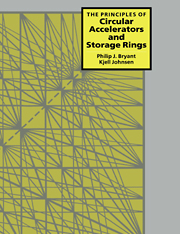Book contents
- Frontmatter
- Contents
- Foreword
- Coordinate system
- Symbols
- Useful Constants
- 1 Introduction
- 2 Basic concepts and constant-gradient focusing
- 3 Alternating-gradient focusing
- 4 Parameterisation of the transverse motion
- 5 Imperfections and resonances
- 6 Chromaticity
- 7 Longitudinal beam dynamics
- 8 Image and space-charge forces (transverse)
- 9 Coherent instabilities
- 10 Radiating particles
- 11 Diagnosis and compensation
- 12 Special aspects of circular colliders
- Appendix A Transverse particle motion in an accelerator
- Appendix B Accelerator magnets
- Appendix C Closed orbits
- Appendix D Phase equation
- Appendix E Vlasov equation
- References
- Index
Appendix A - Transverse particle motion in an accelerator
Published online by Cambridge University Press: 11 November 2009
- Frontmatter
- Contents
- Foreword
- Coordinate system
- Symbols
- Useful Constants
- 1 Introduction
- 2 Basic concepts and constant-gradient focusing
- 3 Alternating-gradient focusing
- 4 Parameterisation of the transverse motion
- 5 Imperfections and resonances
- 6 Chromaticity
- 7 Longitudinal beam dynamics
- 8 Image and space-charge forces (transverse)
- 9 Coherent instabilities
- 10 Radiating particles
- 11 Diagnosis and compensation
- 12 Special aspects of circular colliders
- Appendix A Transverse particle motion in an accelerator
- Appendix B Accelerator magnets
- Appendix C Closed orbits
- Appendix D Phase equation
- Appendix E Vlasov equation
- References
- Index
Summary
The derivations given in Chapters 2 and 3 for the transverse motion appear very simple and easy to understand, which was the motivation for doing them in the way shown. The final results are valid and are universally applied, but behind this economy of the truth there are some pitfalls.
As often happens in applied physics, the final expressions are relatively simple, but only as a result of making a number of approximations, which are justified as having very small effects. Usually this is fully satisfactory compared to the desired accuracy, but in some cases, after very many oscillations of the system, the consequences may no longer be negligible. In such cases the approximations are violating, however slightly, some fundamental principle of physics, which for accelerators will be seen later to be the conservation of phase space. The same problem reappears in celestial mechanics where again expressions are required that will accurately represent the motion of a planetary system through extremely large numbers of oscillations. In both cases the conservation of phase space must be rigorously observed. At present there is a lot of research activity motivated by the design of new accelerators to determine the limit between stability and instability for very large numbers of oscillations in the presence of non-linear fields. It is therefore imperative to be sure that at least the equations for the simple linear motion are stable and to find a safe method for treating this and more complicated cases.
- Type
- Chapter
- Information
- The Principles of Circular Accelerators and Storage Rings , pp. 309 - 316Publisher: Cambridge University PressPrint publication year: 1993



